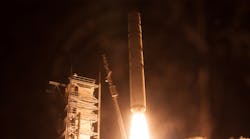WALLOPS ISLAND - NASA has launched an unmanned spacecraft that aims to study the Moon's atmosphere, the US space agency's third lunar probe in five years.
Blazing a red path in the night sky, the spacecraft lifted off at 11:27 p.m. Friday aboard a converted Air Force ballistic missile known as the Minotaur V rocket from NASA's Wallops Flight Facility in Virginia.
NASA said there was a "situation" with the spacecraft's reaction wheels, which help orient the spacecraft, without elaborating.
“The spacecraft is communicating and working as designed, with plenty of time to resolve the issue before reaching lunar orbit," it added on its website.
The Lunar Atmosphere and Dust Environment Explorer (LADEE) hopes to learn more about the atmosphere and dust while circling the Moon.
Launch manager Doug Voss said the maiden mission for the five-stage rocket operated by Orbital Sciences Corporation was "nearly picture-perfect."
"It's quite a great ending to what has been a fantastic mission, a very unique mission."
When U.S. astronauts last walked on the Moon four decades ago, they learned that dust could be a huge problem for sensitive spacecraft and equipment, said space expert John Logsdon.
"If we were ever to go there with people for long duration, the dust gets in everything. It's not smooth dust like a piece of sand on the beach. It's made of very, very small fragments," said Logsdon, a NASA adviser and former director of the Space Policy Institute at George Washington University.
"All the Apollo crews complained about the lunar dust getting everywhere."
U.S. astronauts first walked on the Moon in 1969, and the last explorers of the Apollo era visited in 1972.
The Moon's atmosphere is so thin that its molecules do not collide, in what is known as an exosphere.
Exploring that exosphere will be a $280 million solar and lithium battery-powered spacecraft about the size of a small car - nearly eight feet tall and five feet wide.
The journey to the Moon will take a full month.
When the spacecraft first enters the Moon's orbit Oct. 6, it will cruise at a height of about 155 miles for 40 days, and then move lower at 12.4 to 37.3 miles from the surface for the science portion of its mission.
It is carrying an Earth-to-Moon laser beam technology demonstration and three main tools, including a neutral mass spectrometer to measure chemical variations in the lunar atmosphere and other tools to analyze exosphere gasses and lunar dust grains.
"These measurements will help scientists address longstanding mysteries, including: was lunar dust, electrically charged by solar ultraviolet light, responsible for the pre-sunrise horizon glow that the Apollo astronauts saw?" NASA said.
Other instruments will seek out water molecules in the lunar atmosphere.
One hundred days into the science portion of the mission, LADEE will make a death plunge into the Moon's surface.
The spacecraft was made in a modular design that aims to "ease the manufacturing and assembly process" and "drastically reduce the cost of spacecraft development," NASA said.
This module could pave the way for unmanned probes to an asteroid or to Mars, as well as future Moon probes, though none are planned for now.
LADEE was conceived when NASA was planning to return humans to the Moon as part of the Constellation program, which President Barack Obama cancelled in 2010 for being over budget and redundant in its goals.
NASA's next big human exploration project plans to send humans to Mars by the 2030s.
Recent NASA robotic missions include the Lunar Reconnaissance Orbiter, which returned troves of images detailing the Moon's cratered surface, and the Gravity Recovery and Interior Laboratory (GRAIL), which revealed how being pummeled by asteroids resulted in the Moon's uneven patches of gravity.
A previous NASA satellite, the Lunar Crater Observation and Sensing Satellite (LCROSS), discovered water ice when it impacted in 2009, the space agency said.
Copyright Agence France-Presse, 2013



